Discussing Historical Developments in the Tourism Industry
VerifiedAdded on 2023/06/18
|8
|3545
|426
Essay
AI Summary
This essay critically discusses the historical trends and developments that have shaped the tourism industry. It begins by defining tourism, hospitality, and leisure, highlighting their interconnectedness. The essay then explores the various sectors within the tourism industry, including transportation, accommodation, food and beverage, and entertainment. It traces the evolution of tourism from ancient times, when travel was primarily for conquest and resource acquisition, to the rise of leisure travel and the modern era following the World Wars. Key trends such as globalization, bleisure travel, the emergence of digital nomads, and experience tourism are examined. The essay also delves into the increasing importance of cultural tourism, technological advancements like online bookings and mobile applications, the personalization of travel experiences, and the growing emphasis on sustainable and eco-friendly tourism practices. It concludes by noting the increasing popularity of solo travel and the ongoing evolution of the tourism industry in response to technological advancements and changing consumer preferences.
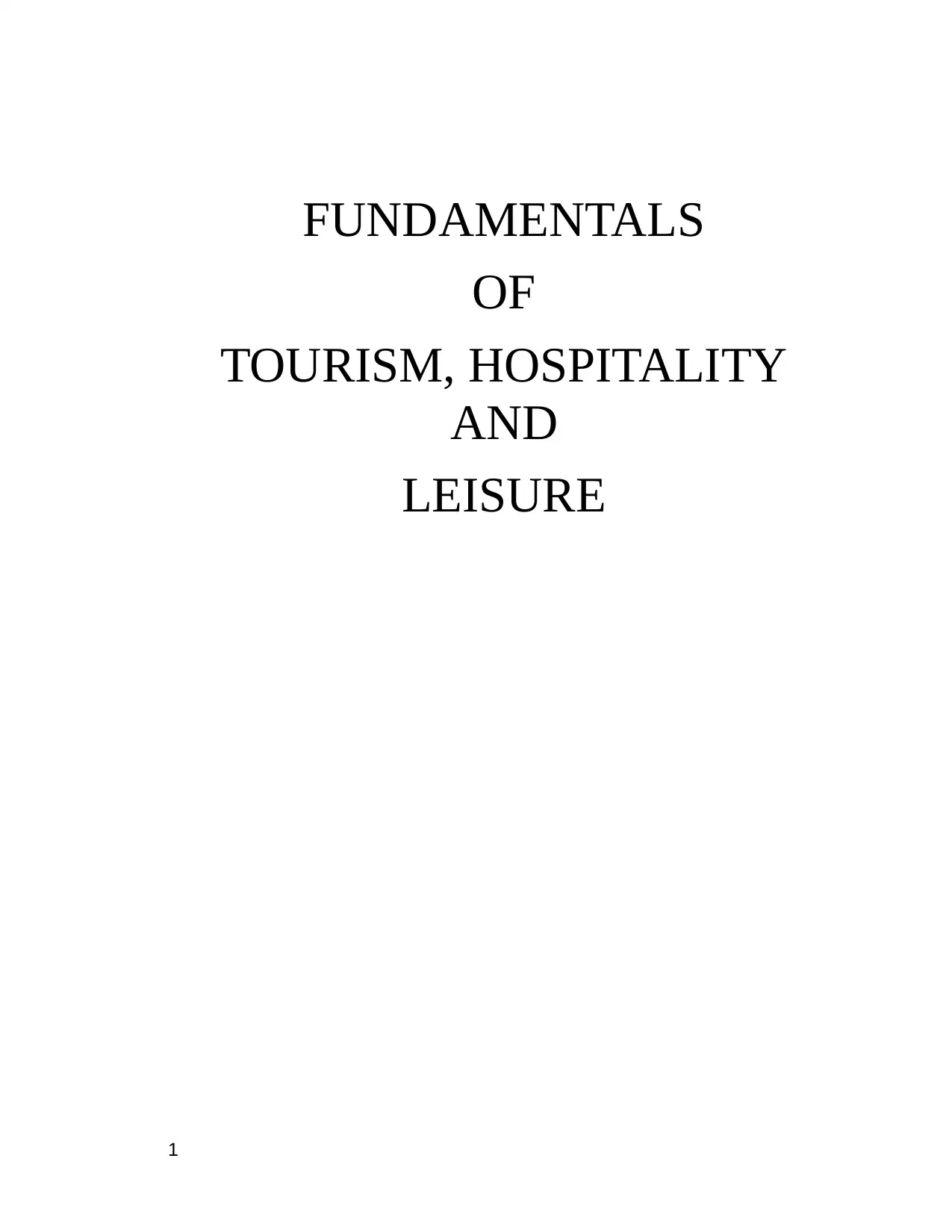
FUNDAMENTALS
OF
TOURISM, HOSPITALITY
AND
LEISURE
1
OF
TOURISM, HOSPITALITY
AND
LEISURE
1
Paraphrase This Document
Need a fresh take? Get an instant paraphrase of this document with our AI Paraphraser
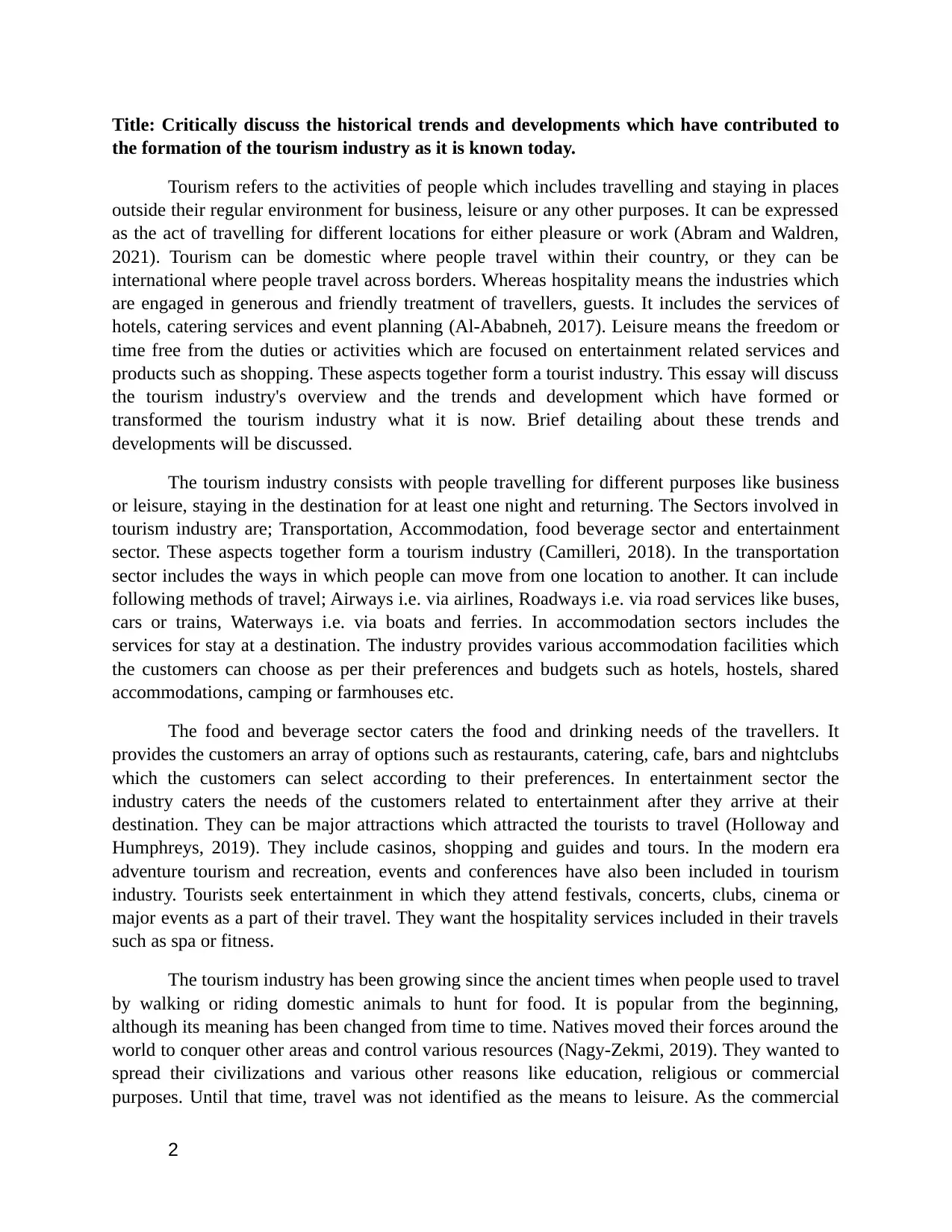
Title: Critically discuss the historical trends and developments which have contributed to
the formation of the tourism industry as it is known today.
Tourism refers to the activities of people which includes travelling and staying in places
outside their regular environment for business, leisure or any other purposes. It can be expressed
as the act of travelling for different locations for either pleasure or work (Abram and Waldren,
2021). Tourism can be domestic where people travel within their country, or they can be
international where people travel across borders. Whereas hospitality means the industries which
are engaged in generous and friendly treatment of travellers, guests. It includes the services of
hotels, catering services and event planning (Al-Ababneh, 2017). Leisure means the freedom or
time free from the duties or activities which are focused on entertainment related services and
products such as shopping. These aspects together form a tourist industry. This essay will discuss
the tourism industry's overview and the trends and development which have formed or
transformed the tourism industry what it is now. Brief detailing about these trends and
developments will be discussed.
The tourism industry consists with people travelling for different purposes like business
or leisure, staying in the destination for at least one night and returning. The Sectors involved in
tourism industry are; Transportation, Accommodation, food beverage sector and entertainment
sector. These aspects together form a tourism industry (Camilleri, 2018). In the transportation
sector includes the ways in which people can move from one location to another. It can include
following methods of travel; Airways i.e. via airlines, Roadways i.e. via road services like buses,
cars or trains, Waterways i.e. via boats and ferries. In accommodation sectors includes the
services for stay at a destination. The industry provides various accommodation facilities which
the customers can choose as per their preferences and budgets such as hotels, hostels, shared
accommodations, camping or farmhouses etc.
The food and beverage sector caters the food and drinking needs of the travellers. It
provides the customers an array of options such as restaurants, catering, cafe, bars and nightclubs
which the customers can select according to their preferences. In entertainment sector the
industry caters the needs of the customers related to entertainment after they arrive at their
destination. They can be major attractions which attracted the tourists to travel (Holloway and
Humphreys, 2019). They include casinos, shopping and guides and tours. In the modern era
adventure tourism and recreation, events and conferences have also been included in tourism
industry. Tourists seek entertainment in which they attend festivals, concerts, clubs, cinema or
major events as a part of their travel. They want the hospitality services included in their travels
such as spa or fitness.
The tourism industry has been growing since the ancient times when people used to travel
by walking or riding domestic animals to hunt for food. It is popular from the beginning,
although its meaning has been changed from time to time. Natives moved their forces around the
world to conquer other areas and control various resources (Nagy-Zekmi, 2019). They wanted to
spread their civilizations and various other reasons like education, religious or commercial
purposes. Until that time, travel was not identified as the means to leisure. As the commercial
2
the formation of the tourism industry as it is known today.
Tourism refers to the activities of people which includes travelling and staying in places
outside their regular environment for business, leisure or any other purposes. It can be expressed
as the act of travelling for different locations for either pleasure or work (Abram and Waldren,
2021). Tourism can be domestic where people travel within their country, or they can be
international where people travel across borders. Whereas hospitality means the industries which
are engaged in generous and friendly treatment of travellers, guests. It includes the services of
hotels, catering services and event planning (Al-Ababneh, 2017). Leisure means the freedom or
time free from the duties or activities which are focused on entertainment related services and
products such as shopping. These aspects together form a tourist industry. This essay will discuss
the tourism industry's overview and the trends and development which have formed or
transformed the tourism industry what it is now. Brief detailing about these trends and
developments will be discussed.
The tourism industry consists with people travelling for different purposes like business
or leisure, staying in the destination for at least one night and returning. The Sectors involved in
tourism industry are; Transportation, Accommodation, food beverage sector and entertainment
sector. These aspects together form a tourism industry (Camilleri, 2018). In the transportation
sector includes the ways in which people can move from one location to another. It can include
following methods of travel; Airways i.e. via airlines, Roadways i.e. via road services like buses,
cars or trains, Waterways i.e. via boats and ferries. In accommodation sectors includes the
services for stay at a destination. The industry provides various accommodation facilities which
the customers can choose as per their preferences and budgets such as hotels, hostels, shared
accommodations, camping or farmhouses etc.
The food and beverage sector caters the food and drinking needs of the travellers. It
provides the customers an array of options such as restaurants, catering, cafe, bars and nightclubs
which the customers can select according to their preferences. In entertainment sector the
industry caters the needs of the customers related to entertainment after they arrive at their
destination. They can be major attractions which attracted the tourists to travel (Holloway and
Humphreys, 2019). They include casinos, shopping and guides and tours. In the modern era
adventure tourism and recreation, events and conferences have also been included in tourism
industry. Tourists seek entertainment in which they attend festivals, concerts, clubs, cinema or
major events as a part of their travel. They want the hospitality services included in their travels
such as spa or fitness.
The tourism industry has been growing since the ancient times when people used to travel
by walking or riding domestic animals to hunt for food. It is popular from the beginning,
although its meaning has been changed from time to time. Natives moved their forces around the
world to conquer other areas and control various resources (Nagy-Zekmi, 2019). They wanted to
spread their civilizations and various other reasons like education, religious or commercial
purposes. Until that time, travel was not identified as the means to leisure. As the commercial
2
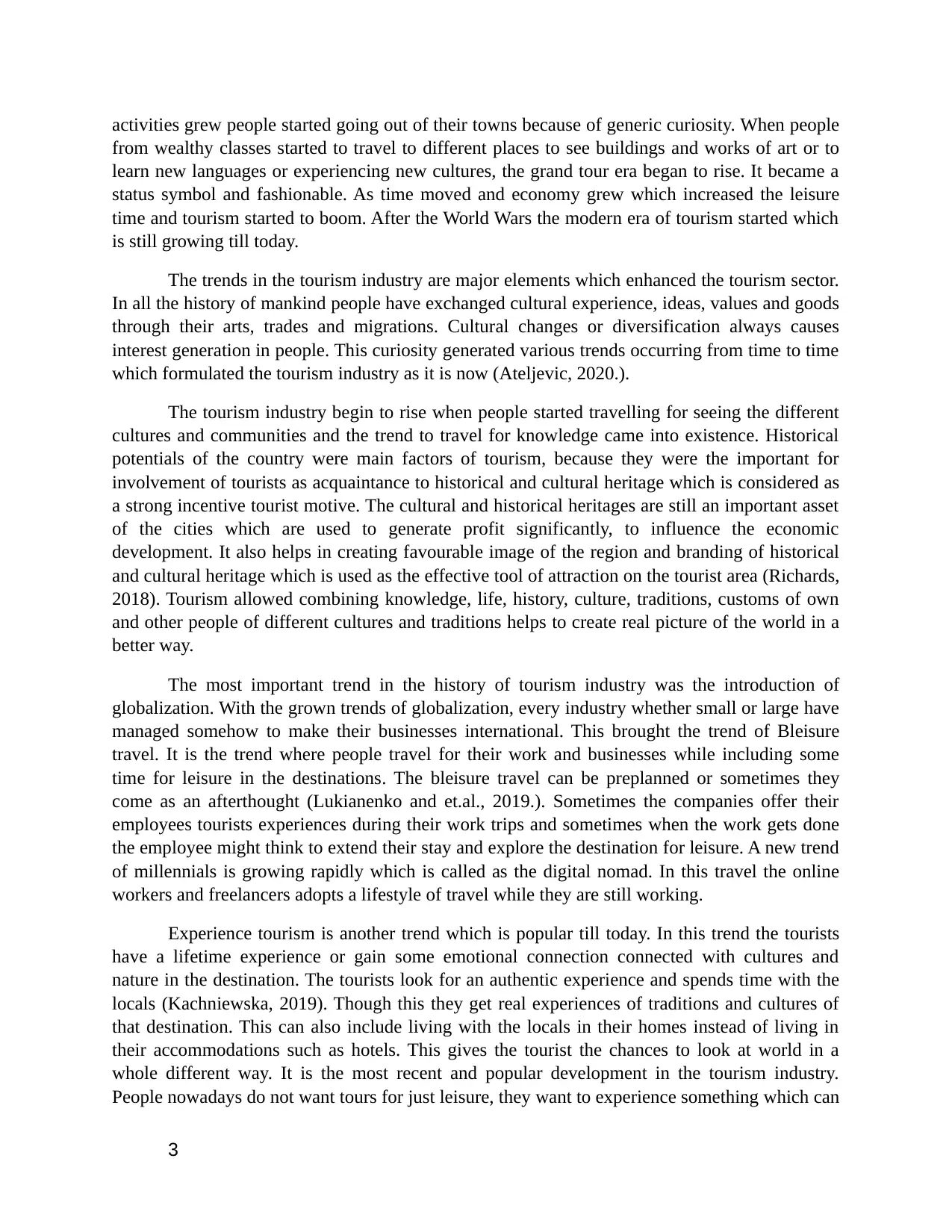
activities grew people started going out of their towns because of generic curiosity. When people
from wealthy classes started to travel to different places to see buildings and works of art or to
learn new languages or experiencing new cultures, the grand tour era began to rise. It became a
status symbol and fashionable. As time moved and economy grew which increased the leisure
time and tourism started to boom. After the World Wars the modern era of tourism started which
is still growing till today.
The trends in the tourism industry are major elements which enhanced the tourism sector.
In all the history of mankind people have exchanged cultural experience, ideas, values and goods
through their arts, trades and migrations. Cultural changes or diversification always causes
interest generation in people. This curiosity generated various trends occurring from time to time
which formulated the tourism industry as it is now (Ateljevic, 2020.).
The tourism industry begin to rise when people started travelling for seeing the different
cultures and communities and the trend to travel for knowledge came into existence. Historical
potentials of the country were main factors of tourism, because they were the important for
involvement of tourists as acquaintance to historical and cultural heritage which is considered as
a strong incentive tourist motive. The cultural and historical heritages are still an important asset
of the cities which are used to generate profit significantly, to influence the economic
development. It also helps in creating favourable image of the region and branding of historical
and cultural heritage which is used as the effective tool of attraction on the tourist area (Richards,
2018). Tourism allowed combining knowledge, life, history, culture, traditions, customs of own
and other people of different cultures and traditions helps to create real picture of the world in a
better way.
The most important trend in the history of tourism industry was the introduction of
globalization. With the grown trends of globalization, every industry whether small or large have
managed somehow to make their businesses international. This brought the trend of Bleisure
travel. It is the trend where people travel for their work and businesses while including some
time for leisure in the destinations. The bleisure travel can be preplanned or sometimes they
come as an afterthought (Lukianenko and et.al., 2019.). Sometimes the companies offer their
employees tourists experiences during their work trips and sometimes when the work gets done
the employee might think to extend their stay and explore the destination for leisure. A new trend
of millennials is growing rapidly which is called as the digital nomad. In this travel the online
workers and freelancers adopts a lifestyle of travel while they are still working.
Experience tourism is another trend which is popular till today. In this trend the tourists
have a lifetime experience or gain some emotional connection connected with cultures and
nature in the destination. The tourists look for an authentic experience and spends time with the
locals (Kachniewska, 2019). Though this they get real experiences of traditions and cultures of
that destination. This can also include living with the locals in their homes instead of living in
their accommodations such as hotels. This gives the tourist the chances to look at world in a
whole different way. It is the most recent and popular development in the tourism industry.
People nowadays do not want tours for just leisure, they want to experience something which can
3
from wealthy classes started to travel to different places to see buildings and works of art or to
learn new languages or experiencing new cultures, the grand tour era began to rise. It became a
status symbol and fashionable. As time moved and economy grew which increased the leisure
time and tourism started to boom. After the World Wars the modern era of tourism started which
is still growing till today.
The trends in the tourism industry are major elements which enhanced the tourism sector.
In all the history of mankind people have exchanged cultural experience, ideas, values and goods
through their arts, trades and migrations. Cultural changes or diversification always causes
interest generation in people. This curiosity generated various trends occurring from time to time
which formulated the tourism industry as it is now (Ateljevic, 2020.).
The tourism industry begin to rise when people started travelling for seeing the different
cultures and communities and the trend to travel for knowledge came into existence. Historical
potentials of the country were main factors of tourism, because they were the important for
involvement of tourists as acquaintance to historical and cultural heritage which is considered as
a strong incentive tourist motive. The cultural and historical heritages are still an important asset
of the cities which are used to generate profit significantly, to influence the economic
development. It also helps in creating favourable image of the region and branding of historical
and cultural heritage which is used as the effective tool of attraction on the tourist area (Richards,
2018). Tourism allowed combining knowledge, life, history, culture, traditions, customs of own
and other people of different cultures and traditions helps to create real picture of the world in a
better way.
The most important trend in the history of tourism industry was the introduction of
globalization. With the grown trends of globalization, every industry whether small or large have
managed somehow to make their businesses international. This brought the trend of Bleisure
travel. It is the trend where people travel for their work and businesses while including some
time for leisure in the destinations. The bleisure travel can be preplanned or sometimes they
come as an afterthought (Lukianenko and et.al., 2019.). Sometimes the companies offer their
employees tourists experiences during their work trips and sometimes when the work gets done
the employee might think to extend their stay and explore the destination for leisure. A new trend
of millennials is growing rapidly which is called as the digital nomad. In this travel the online
workers and freelancers adopts a lifestyle of travel while they are still working.
Experience tourism is another trend which is popular till today. In this trend the tourists
have a lifetime experience or gain some emotional connection connected with cultures and
nature in the destination. The tourists look for an authentic experience and spends time with the
locals (Kachniewska, 2019). Though this they get real experiences of traditions and cultures of
that destination. This can also include living with the locals in their homes instead of living in
their accommodations such as hotels. This gives the tourist the chances to look at world in a
whole different way. It is the most recent and popular development in the tourism industry.
People nowadays do not want tours for just leisure, they want to experience something which can
3
⊘ This is a preview!⊘
Do you want full access?
Subscribe today to unlock all pages.

Trusted by 1+ million students worldwide
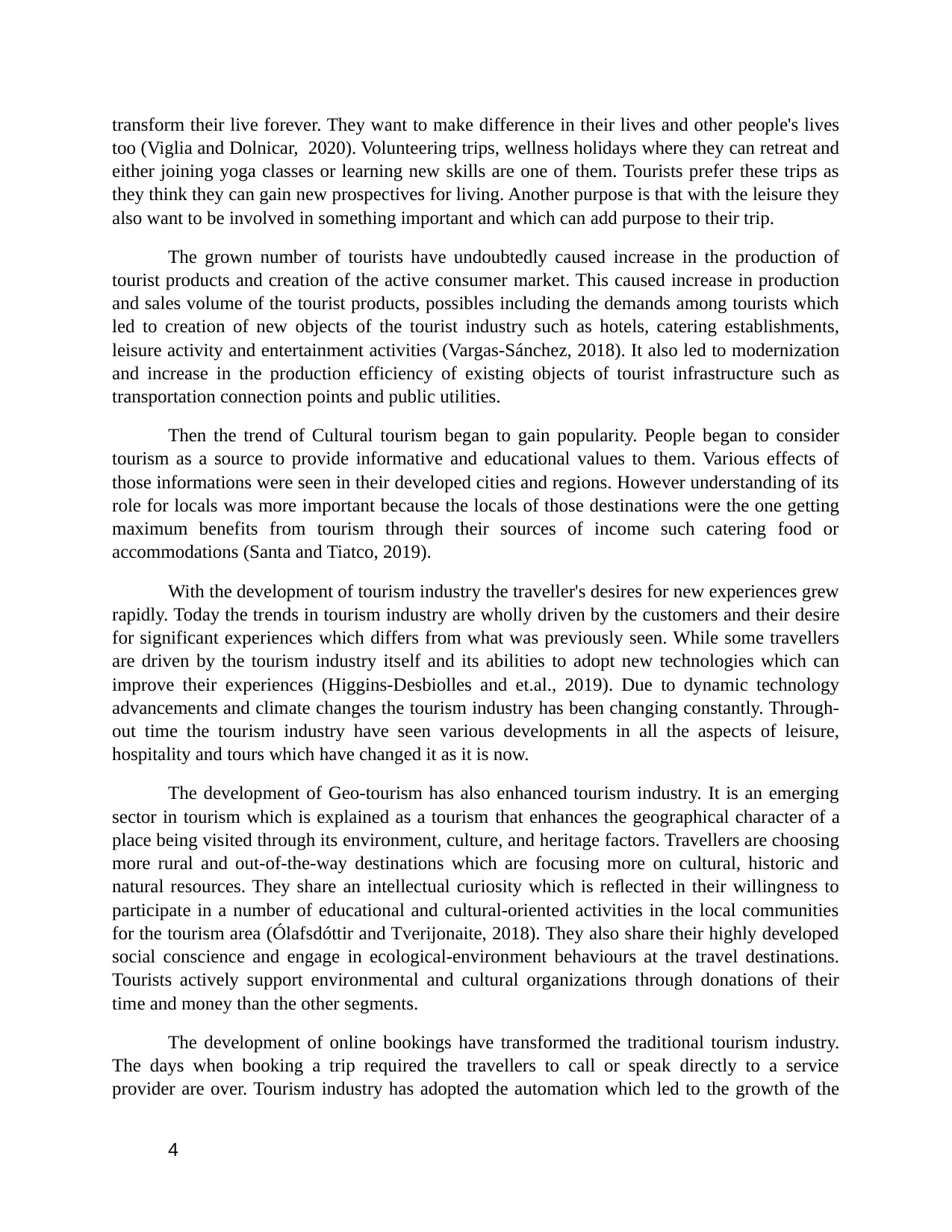
transform their live forever. They want to make difference in their lives and other people's lives
too (Viglia and Dolnicar, 2020). Volunteering trips, wellness holidays where they can retreat and
either joining yoga classes or learning new skills are one of them. Tourists prefer these trips as
they think they can gain new prospectives for living. Another purpose is that with the leisure they
also want to be involved in something important and which can add purpose to their trip.
The grown number of tourists have undoubtedly caused increase in the production of
tourist products and creation of the active consumer market. This caused increase in production
and sales volume of the tourist products, possibles including the demands among tourists which
led to creation of new objects of the tourist industry such as hotels, catering establishments,
leisure activity and entertainment activities (Vargas-Sánchez, 2018). It also led to modernization
and increase in the production efficiency of existing objects of tourist infrastructure such as
transportation connection points and public utilities.
Then the trend of Cultural tourism began to gain popularity. People began to consider
tourism as a source to provide informative and educational values to them. Various effects of
those informations were seen in their developed cities and regions. However understanding of its
role for locals was more important because the locals of those destinations were the one getting
maximum benefits from tourism through their sources of income such catering food or
accommodations (Santa and Tiatco, 2019).
With the development of tourism industry the traveller's desires for new experiences grew
rapidly. Today the trends in tourism industry are wholly driven by the customers and their desire
for significant experiences which differs from what was previously seen. While some travellers
are driven by the tourism industry itself and its abilities to adopt new technologies which can
improve their experiences (Higgins-Desbiolles and et.al., 2019). Due to dynamic technology
advancements and climate changes the tourism industry has been changing constantly. Through-
out time the tourism industry have seen various developments in all the aspects of leisure,
hospitality and tours which have changed it as it is now.
The development of Geo-tourism has also enhanced tourism industry. It is an emerging
sector in tourism which is explained as a tourism that enhances the geographical character of a
place being visited through its environment, culture, and heritage factors. Travellers are choosing
more rural and out-of-the-way destinations which are focusing more on cultural, historic and
natural resources. They share an intellectual curiosity which is reflected in their willingness to
participate in a number of educational and cultural-oriented activities in the local communities
for the tourism area (Ólafsdóttir and Tverijonaite, 2018). They also share their highly developed
social conscience and engage in ecological-environment behaviours at the travel destinations.
Tourists actively support environmental and cultural organizations through donations of their
time and money than the other segments.
The development of online bookings have transformed the traditional tourism industry.
The days when booking a trip required the travellers to call or speak directly to a service
provider are over. Tourism industry has adopted the automation which led to the growth of the
4
too (Viglia and Dolnicar, 2020). Volunteering trips, wellness holidays where they can retreat and
either joining yoga classes or learning new skills are one of them. Tourists prefer these trips as
they think they can gain new prospectives for living. Another purpose is that with the leisure they
also want to be involved in something important and which can add purpose to their trip.
The grown number of tourists have undoubtedly caused increase in the production of
tourist products and creation of the active consumer market. This caused increase in production
and sales volume of the tourist products, possibles including the demands among tourists which
led to creation of new objects of the tourist industry such as hotels, catering establishments,
leisure activity and entertainment activities (Vargas-Sánchez, 2018). It also led to modernization
and increase in the production efficiency of existing objects of tourist infrastructure such as
transportation connection points and public utilities.
Then the trend of Cultural tourism began to gain popularity. People began to consider
tourism as a source to provide informative and educational values to them. Various effects of
those informations were seen in their developed cities and regions. However understanding of its
role for locals was more important because the locals of those destinations were the one getting
maximum benefits from tourism through their sources of income such catering food or
accommodations (Santa and Tiatco, 2019).
With the development of tourism industry the traveller's desires for new experiences grew
rapidly. Today the trends in tourism industry are wholly driven by the customers and their desire
for significant experiences which differs from what was previously seen. While some travellers
are driven by the tourism industry itself and its abilities to adopt new technologies which can
improve their experiences (Higgins-Desbiolles and et.al., 2019). Due to dynamic technology
advancements and climate changes the tourism industry has been changing constantly. Through-
out time the tourism industry have seen various developments in all the aspects of leisure,
hospitality and tours which have changed it as it is now.
The development of Geo-tourism has also enhanced tourism industry. It is an emerging
sector in tourism which is explained as a tourism that enhances the geographical character of a
place being visited through its environment, culture, and heritage factors. Travellers are choosing
more rural and out-of-the-way destinations which are focusing more on cultural, historic and
natural resources. They share an intellectual curiosity which is reflected in their willingness to
participate in a number of educational and cultural-oriented activities in the local communities
for the tourism area (Ólafsdóttir and Tverijonaite, 2018). They also share their highly developed
social conscience and engage in ecological-environment behaviours at the travel destinations.
Tourists actively support environmental and cultural organizations through donations of their
time and money than the other segments.
The development of online bookings have transformed the traditional tourism industry.
The days when booking a trip required the travellers to call or speak directly to a service
provider are over. Tourism industry has adopted the automation which led to the growth of the
4
Paraphrase This Document
Need a fresh take? Get an instant paraphrase of this document with our AI Paraphraser
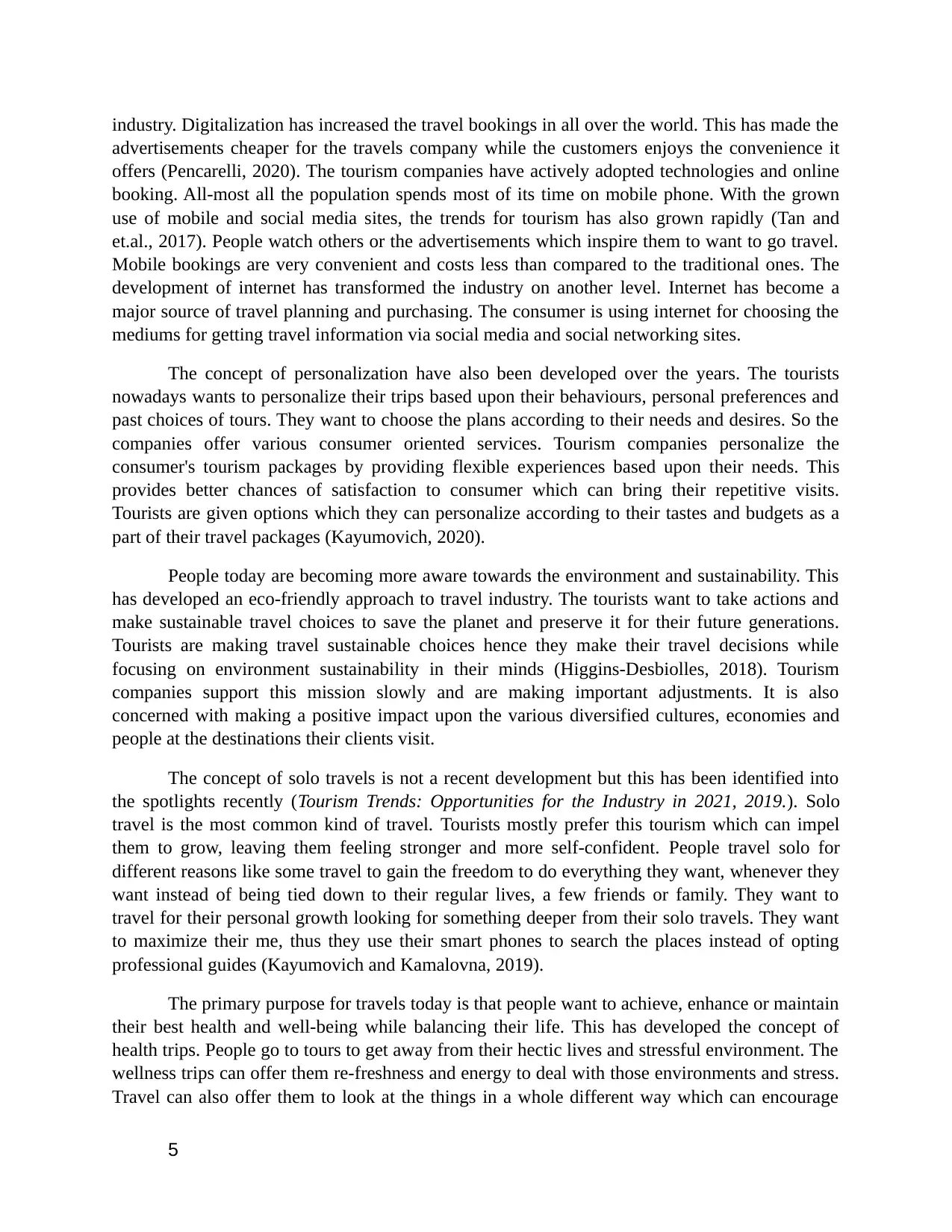
industry. Digitalization has increased the travel bookings in all over the world. This has made the
advertisements cheaper for the travels company while the customers enjoys the convenience it
offers (Pencarelli, 2020). The tourism companies have actively adopted technologies and online
booking. All-most all the population spends most of its time on mobile phone. With the grown
use of mobile and social media sites, the trends for tourism has also grown rapidly (Tan and
et.al., 2017). People watch others or the advertisements which inspire them to want to go travel.
Mobile bookings are very convenient and costs less than compared to the traditional ones. The
development of internet has transformed the industry on another level. Internet has become a
major source of travel planning and purchasing. The consumer is using internet for choosing the
mediums for getting travel information via social media and social networking sites.
The concept of personalization have also been developed over the years. The tourists
nowadays wants to personalize their trips based upon their behaviours, personal preferences and
past choices of tours. They want to choose the plans according to their needs and desires. So the
companies offer various consumer oriented services. Tourism companies personalize the
consumer's tourism packages by providing flexible experiences based upon their needs. This
provides better chances of satisfaction to consumer which can bring their repetitive visits.
Tourists are given options which they can personalize according to their tastes and budgets as a
part of their travel packages (Kayumovich, 2020).
People today are becoming more aware towards the environment and sustainability. This
has developed an eco-friendly approach to travel industry. The tourists want to take actions and
make sustainable travel choices to save the planet and preserve it for their future generations.
Tourists are making travel sustainable choices hence they make their travel decisions while
focusing on environment sustainability in their minds (Higgins-Desbiolles, 2018). Tourism
companies support this mission slowly and are making important adjustments. It is also
concerned with making a positive impact upon the various diversified cultures, economies and
people at the destinations their clients visit.
The concept of solo travels is not a recent development but this has been identified into
the spotlights recently (Tourism Trends: Opportunities for the Industry in 2021, 2019.). Solo
travel is the most common kind of travel. Tourists mostly prefer this tourism which can impel
them to grow, leaving them feeling stronger and more self-confident. People travel solo for
different reasons like some travel to gain the freedom to do everything they want, whenever they
want instead of being tied down to their regular lives, a few friends or family. They want to
travel for their personal growth looking for something deeper from their solo travels. They want
to maximize their me, thus they use their smart phones to search the places instead of opting
professional guides (Kayumovich and Kamalovna, 2019).
The primary purpose for travels today is that people want to achieve, enhance or maintain
their best health and well-being while balancing their life. This has developed the concept of
health trips. People go to tours to get away from their hectic lives and stressful environment. The
wellness trips can offer them re-freshness and energy to deal with those environments and stress.
Travel can also offer them to look at the things in a whole different way which can encourage
5
advertisements cheaper for the travels company while the customers enjoys the convenience it
offers (Pencarelli, 2020). The tourism companies have actively adopted technologies and online
booking. All-most all the population spends most of its time on mobile phone. With the grown
use of mobile and social media sites, the trends for tourism has also grown rapidly (Tan and
et.al., 2017). People watch others or the advertisements which inspire them to want to go travel.
Mobile bookings are very convenient and costs less than compared to the traditional ones. The
development of internet has transformed the industry on another level. Internet has become a
major source of travel planning and purchasing. The consumer is using internet for choosing the
mediums for getting travel information via social media and social networking sites.
The concept of personalization have also been developed over the years. The tourists
nowadays wants to personalize their trips based upon their behaviours, personal preferences and
past choices of tours. They want to choose the plans according to their needs and desires. So the
companies offer various consumer oriented services. Tourism companies personalize the
consumer's tourism packages by providing flexible experiences based upon their needs. This
provides better chances of satisfaction to consumer which can bring their repetitive visits.
Tourists are given options which they can personalize according to their tastes and budgets as a
part of their travel packages (Kayumovich, 2020).
People today are becoming more aware towards the environment and sustainability. This
has developed an eco-friendly approach to travel industry. The tourists want to take actions and
make sustainable travel choices to save the planet and preserve it for their future generations.
Tourists are making travel sustainable choices hence they make their travel decisions while
focusing on environment sustainability in their minds (Higgins-Desbiolles, 2018). Tourism
companies support this mission slowly and are making important adjustments. It is also
concerned with making a positive impact upon the various diversified cultures, economies and
people at the destinations their clients visit.
The concept of solo travels is not a recent development but this has been identified into
the spotlights recently (Tourism Trends: Opportunities for the Industry in 2021, 2019.). Solo
travel is the most common kind of travel. Tourists mostly prefer this tourism which can impel
them to grow, leaving them feeling stronger and more self-confident. People travel solo for
different reasons like some travel to gain the freedom to do everything they want, whenever they
want instead of being tied down to their regular lives, a few friends or family. They want to
travel for their personal growth looking for something deeper from their solo travels. They want
to maximize their me, thus they use their smart phones to search the places instead of opting
professional guides (Kayumovich and Kamalovna, 2019).
The primary purpose for travels today is that people want to achieve, enhance or maintain
their best health and well-being while balancing their life. This has developed the concept of
health trips. People go to tours to get away from their hectic lives and stressful environment. The
wellness trips can offer them re-freshness and energy to deal with those environments and stress.
Travel can also offer them to look at the things in a whole different way which can encourage
5
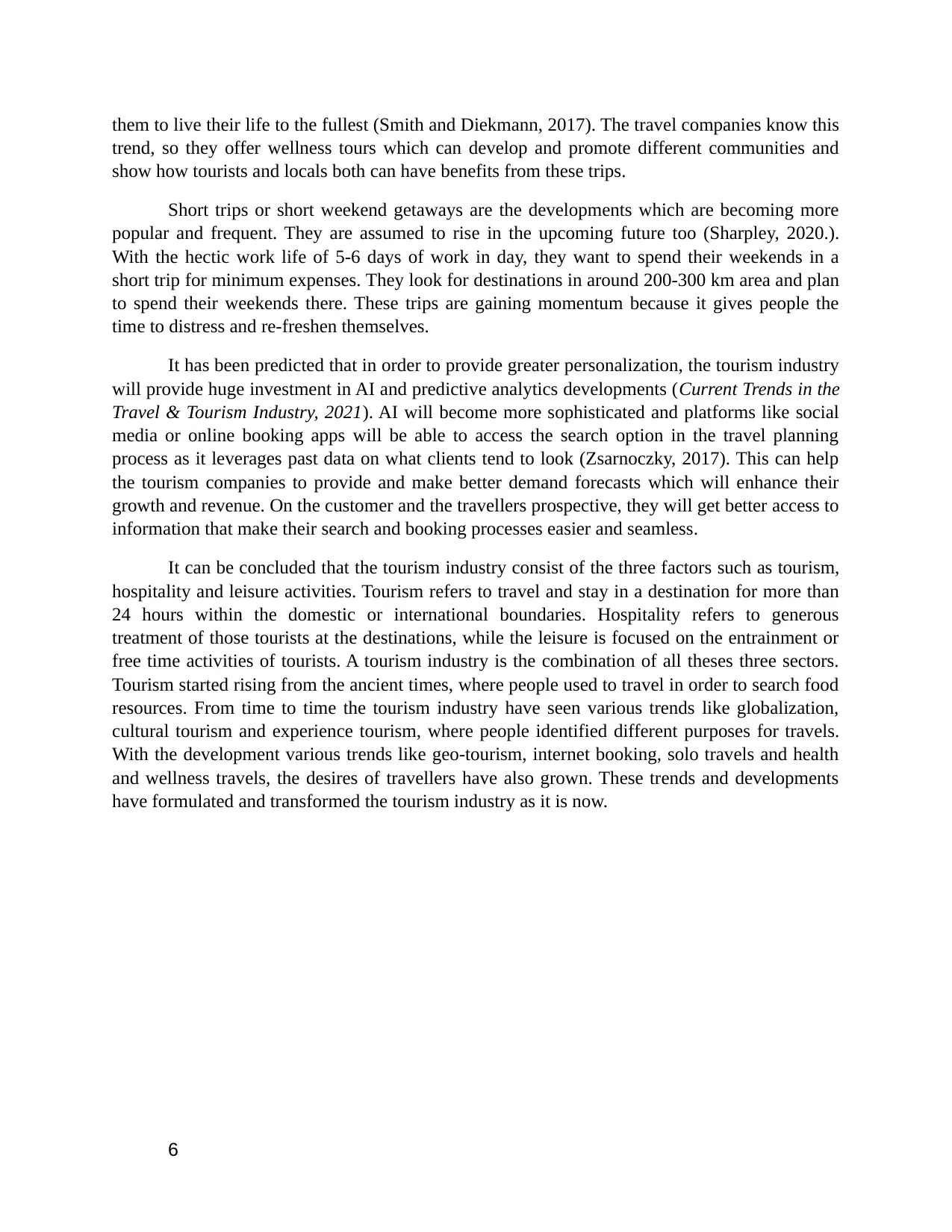
them to live their life to the fullest (Smith and Diekmann, 2017). The travel companies know this
trend, so they offer wellness tours which can develop and promote different communities and
show how tourists and locals both can have benefits from these trips.
Short trips or short weekend getaways are the developments which are becoming more
popular and frequent. They are assumed to rise in the upcoming future too (Sharpley, 2020.).
With the hectic work life of 5-6 days of work in day, they want to spend their weekends in a
short trip for minimum expenses. They look for destinations in around 200-300 km area and plan
to spend their weekends there. These trips are gaining momentum because it gives people the
time to distress and re-freshen themselves.
It has been predicted that in order to provide greater personalization, the tourism industry
will provide huge investment in AI and predictive analytics developments (Current Trends in the
Travel & Tourism Industry, 2021). AI will become more sophisticated and platforms like social
media or online booking apps will be able to access the search option in the travel planning
process as it leverages past data on what clients tend to look (Zsarnoczky, 2017). This can help
the tourism companies to provide and make better demand forecasts which will enhance their
growth and revenue. On the customer and the travellers prospective, they will get better access to
information that make their search and booking processes easier and seamless.
It can be concluded that the tourism industry consist of the three factors such as tourism,
hospitality and leisure activities. Tourism refers to travel and stay in a destination for more than
24 hours within the domestic or international boundaries. Hospitality refers to generous
treatment of those tourists at the destinations, while the leisure is focused on the entrainment or
free time activities of tourists. A tourism industry is the combination of all theses three sectors.
Tourism started rising from the ancient times, where people used to travel in order to search food
resources. From time to time the tourism industry have seen various trends like globalization,
cultural tourism and experience tourism, where people identified different purposes for travels.
With the development various trends like geo-tourism, internet booking, solo travels and health
and wellness travels, the desires of travellers have also grown. These trends and developments
have formulated and transformed the tourism industry as it is now.
6
trend, so they offer wellness tours which can develop and promote different communities and
show how tourists and locals both can have benefits from these trips.
Short trips or short weekend getaways are the developments which are becoming more
popular and frequent. They are assumed to rise in the upcoming future too (Sharpley, 2020.).
With the hectic work life of 5-6 days of work in day, they want to spend their weekends in a
short trip for minimum expenses. They look for destinations in around 200-300 km area and plan
to spend their weekends there. These trips are gaining momentum because it gives people the
time to distress and re-freshen themselves.
It has been predicted that in order to provide greater personalization, the tourism industry
will provide huge investment in AI and predictive analytics developments (Current Trends in the
Travel & Tourism Industry, 2021). AI will become more sophisticated and platforms like social
media or online booking apps will be able to access the search option in the travel planning
process as it leverages past data on what clients tend to look (Zsarnoczky, 2017). This can help
the tourism companies to provide and make better demand forecasts which will enhance their
growth and revenue. On the customer and the travellers prospective, they will get better access to
information that make their search and booking processes easier and seamless.
It can be concluded that the tourism industry consist of the three factors such as tourism,
hospitality and leisure activities. Tourism refers to travel and stay in a destination for more than
24 hours within the domestic or international boundaries. Hospitality refers to generous
treatment of those tourists at the destinations, while the leisure is focused on the entrainment or
free time activities of tourists. A tourism industry is the combination of all theses three sectors.
Tourism started rising from the ancient times, where people used to travel in order to search food
resources. From time to time the tourism industry have seen various trends like globalization,
cultural tourism and experience tourism, where people identified different purposes for travels.
With the development various trends like geo-tourism, internet booking, solo travels and health
and wellness travels, the desires of travellers have also grown. These trends and developments
have formulated and transformed the tourism industry as it is now.
6
⊘ This is a preview!⊘
Do you want full access?
Subscribe today to unlock all pages.

Trusted by 1+ million students worldwide
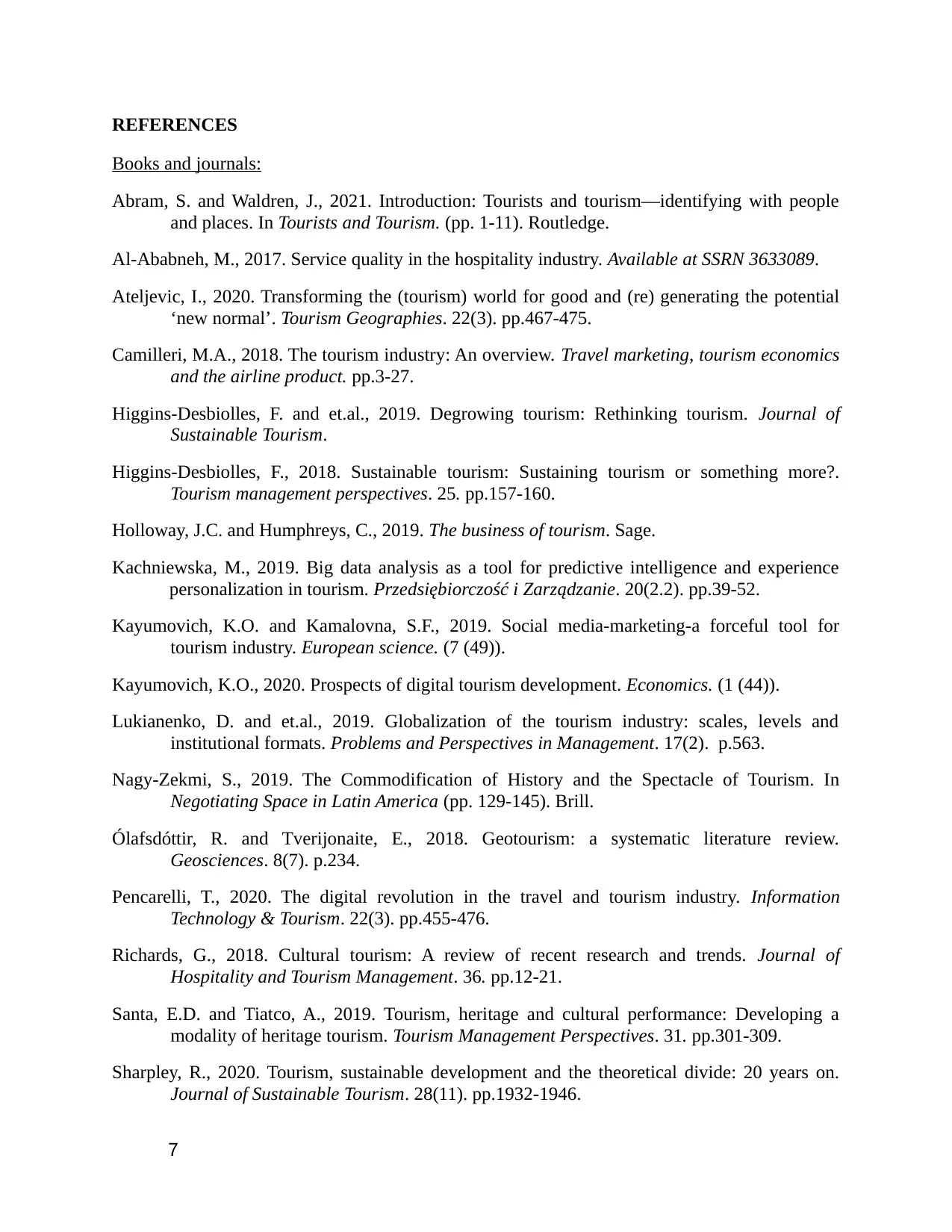
REFERENCES
Books and journals:
Abram, S. and Waldren, J., 2021. Introduction: Tourists and tourism—identifying with people
and places. In Tourists and Tourism. (pp. 1-11). Routledge.
Al-Ababneh, M., 2017. Service quality in the hospitality industry. Available at SSRN 3633089.
Ateljevic, I., 2020. Transforming the (tourism) world for good and (re) generating the potential
‘new normal’. Tourism Geographies. 22(3). pp.467-475.
Camilleri, M.A., 2018. The tourism industry: An overview. Travel marketing, tourism economics
and the airline product. pp.3-27.
Higgins-Desbiolles, F. and et.al., 2019. Degrowing tourism: Rethinking tourism. Journal of
Sustainable Tourism.
Higgins-Desbiolles, F., 2018. Sustainable tourism: Sustaining tourism or something more?.
Tourism management perspectives. 25. pp.157-160.
Holloway, J.C. and Humphreys, C., 2019. The business of tourism. Sage.
Kachniewska, M., 2019. Big data analysis as a tool for predictive intelligence and experience
personalization in tourism. Przedsiębiorczość i Zarządzanie. 20(2.2). pp.39-52.
Kayumovich, K.O. and Kamalovna, S.F., 2019. Social media-marketing-a forceful tool for
tourism industry. European science. (7 (49)).
Kayumovich, K.O., 2020. Prospects of digital tourism development. Economics. (1 (44)).
Lukianenko, D. and et.al., 2019. Globalization of the tourism industry: scales, levels and
institutional formats. Problems and Perspectives in Management. 17(2). p.563.
Nagy-Zekmi, S., 2019. The Commodification of History and the Spectacle of Tourism. In
Negotiating Space in Latin America (pp. 129-145). Brill.
Ólafsdóttir, R. and Tverijonaite, E., 2018. Geotourism: a systematic literature review.
Geosciences. 8(7). p.234.
Pencarelli, T., 2020. The digital revolution in the travel and tourism industry. Information
Technology & Tourism. 22(3). pp.455-476.
Richards, G., 2018. Cultural tourism: A review of recent research and trends. Journal of
Hospitality and Tourism Management. 36. pp.12-21.
Santa, E.D. and Tiatco, A., 2019. Tourism, heritage and cultural performance: Developing a
modality of heritage tourism. Tourism Management Perspectives. 31. pp.301-309.
Sharpley, R., 2020. Tourism, sustainable development and the theoretical divide: 20 years on.
Journal of Sustainable Tourism. 28(11). pp.1932-1946.
7
Books and journals:
Abram, S. and Waldren, J., 2021. Introduction: Tourists and tourism—identifying with people
and places. In Tourists and Tourism. (pp. 1-11). Routledge.
Al-Ababneh, M., 2017. Service quality in the hospitality industry. Available at SSRN 3633089.
Ateljevic, I., 2020. Transforming the (tourism) world for good and (re) generating the potential
‘new normal’. Tourism Geographies. 22(3). pp.467-475.
Camilleri, M.A., 2018. The tourism industry: An overview. Travel marketing, tourism economics
and the airline product. pp.3-27.
Higgins-Desbiolles, F. and et.al., 2019. Degrowing tourism: Rethinking tourism. Journal of
Sustainable Tourism.
Higgins-Desbiolles, F., 2018. Sustainable tourism: Sustaining tourism or something more?.
Tourism management perspectives. 25. pp.157-160.
Holloway, J.C. and Humphreys, C., 2019. The business of tourism. Sage.
Kachniewska, M., 2019. Big data analysis as a tool for predictive intelligence and experience
personalization in tourism. Przedsiębiorczość i Zarządzanie. 20(2.2). pp.39-52.
Kayumovich, K.O. and Kamalovna, S.F., 2019. Social media-marketing-a forceful tool for
tourism industry. European science. (7 (49)).
Kayumovich, K.O., 2020. Prospects of digital tourism development. Economics. (1 (44)).
Lukianenko, D. and et.al., 2019. Globalization of the tourism industry: scales, levels and
institutional formats. Problems and Perspectives in Management. 17(2). p.563.
Nagy-Zekmi, S., 2019. The Commodification of History and the Spectacle of Tourism. In
Negotiating Space in Latin America (pp. 129-145). Brill.
Ólafsdóttir, R. and Tverijonaite, E., 2018. Geotourism: a systematic literature review.
Geosciences. 8(7). p.234.
Pencarelli, T., 2020. The digital revolution in the travel and tourism industry. Information
Technology & Tourism. 22(3). pp.455-476.
Richards, G., 2018. Cultural tourism: A review of recent research and trends. Journal of
Hospitality and Tourism Management. 36. pp.12-21.
Santa, E.D. and Tiatco, A., 2019. Tourism, heritage and cultural performance: Developing a
modality of heritage tourism. Tourism Management Perspectives. 31. pp.301-309.
Sharpley, R., 2020. Tourism, sustainable development and the theoretical divide: 20 years on.
Journal of Sustainable Tourism. 28(11). pp.1932-1946.
7
Paraphrase This Document
Need a fresh take? Get an instant paraphrase of this document with our AI Paraphraser
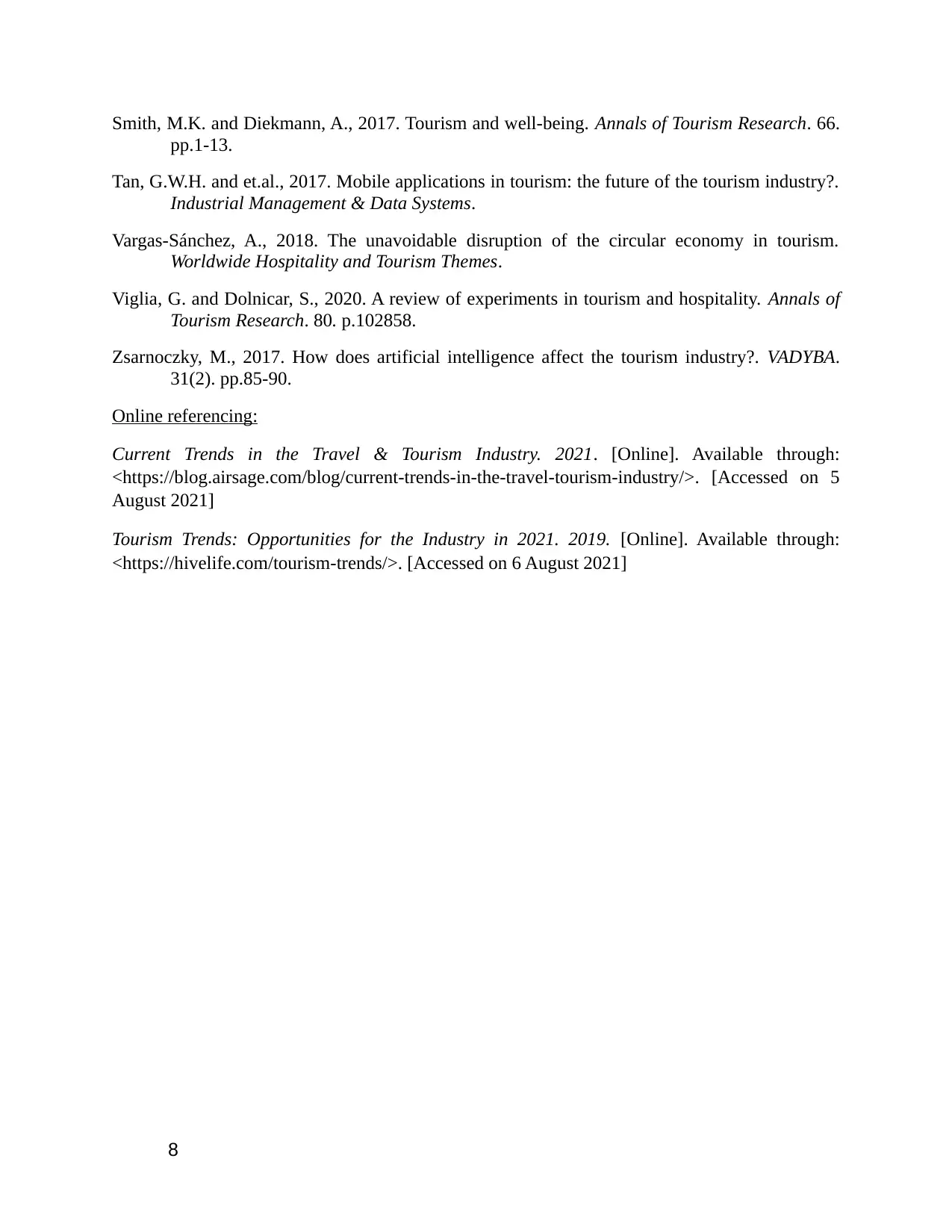
Smith, M.K. and Diekmann, A., 2017. Tourism and well-being. Annals of Tourism Research. 66.
pp.1-13.
Tan, G.W.H. and et.al., 2017. Mobile applications in tourism: the future of the tourism industry?.
Industrial Management & Data Systems.
Vargas-Sánchez, A., 2018. The unavoidable disruption of the circular economy in tourism.
Worldwide Hospitality and Tourism Themes.
Viglia, G. and Dolnicar, S., 2020. A review of experiments in tourism and hospitality. Annals of
Tourism Research. 80. p.102858.
Zsarnoczky, M., 2017. How does artificial intelligence affect the tourism industry?. VADYBA.
31(2). pp.85-90.
Online referencing:
Current Trends in the Travel & Tourism Industry. 2021. [Online]. Available through:
<https://blog.airsage.com/blog/current-trends-in-the-travel-tourism-industry/>. [Accessed on 5
August 2021]
Tourism Trends: Opportunities for the Industry in 2021. 2019. [Online]. Available through:
<https://hivelife.com/tourism-trends/>. [Accessed on 6 August 2021]
8
pp.1-13.
Tan, G.W.H. and et.al., 2017. Mobile applications in tourism: the future of the tourism industry?.
Industrial Management & Data Systems.
Vargas-Sánchez, A., 2018. The unavoidable disruption of the circular economy in tourism.
Worldwide Hospitality and Tourism Themes.
Viglia, G. and Dolnicar, S., 2020. A review of experiments in tourism and hospitality. Annals of
Tourism Research. 80. p.102858.
Zsarnoczky, M., 2017. How does artificial intelligence affect the tourism industry?. VADYBA.
31(2). pp.85-90.
Online referencing:
Current Trends in the Travel & Tourism Industry. 2021. [Online]. Available through:
<https://blog.airsage.com/blog/current-trends-in-the-travel-tourism-industry/>. [Accessed on 5
August 2021]
Tourism Trends: Opportunities for the Industry in 2021. 2019. [Online]. Available through:
<https://hivelife.com/tourism-trends/>. [Accessed on 6 August 2021]
8
1 out of 8
Related Documents
Your All-in-One AI-Powered Toolkit for Academic Success.
+13062052269
info@desklib.com
Available 24*7 on WhatsApp / Email
![[object Object]](/_next/static/media/star-bottom.7253800d.svg)
Unlock your academic potential
Copyright © 2020–2025 A2Z Services. All Rights Reserved. Developed and managed by ZUCOL.





